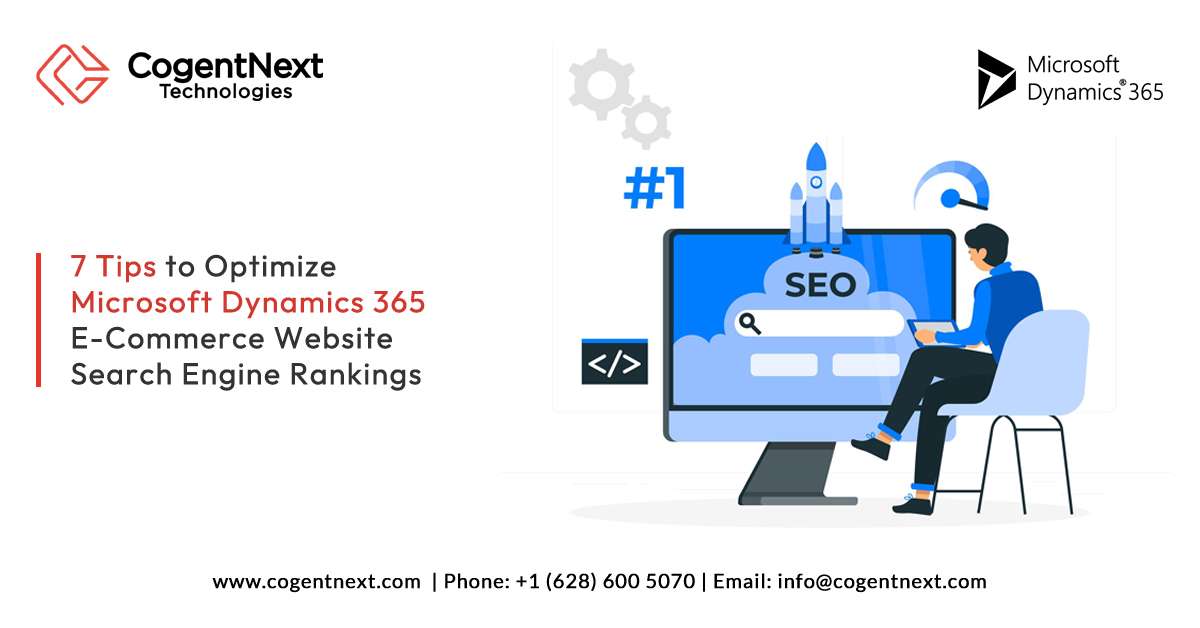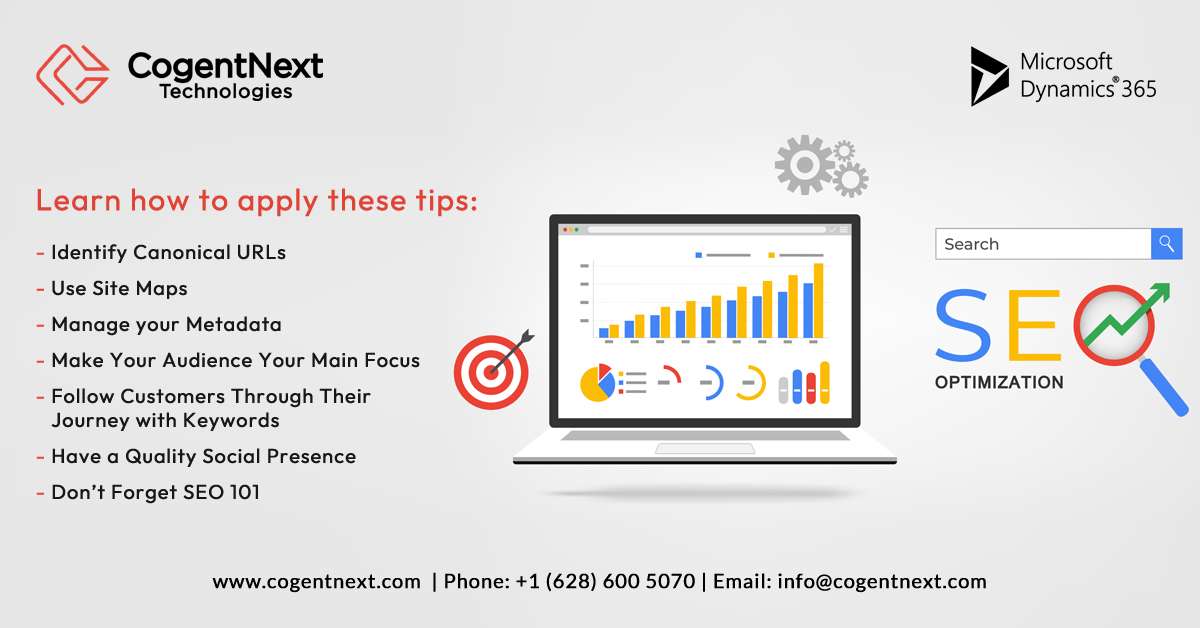
7 SEO Best Practices for Microsoft Dynamics 365 E-Commerce Websites
Sources say that, among many other compelling statistics, 93% of online experiences, including those related to Dynamics 365 E-Commerce, begin with a search engine like Google, Yahoo, or Bing. It is worth noting that 70% to 80% of users tend to ignore paid search results. Furthermore, over 73% of all searches are performed using Google, and a significant 94% of all mobile and tablet search traffic comes from Google.
What do these statistics teach us? Organic search, especially through Google, is quite possibly the most valuable marketing channel currently in existence. Make no mistake, you need Search Engine Optimization (SEO), regardless of the size of your company, or how well-known you are in your community.
If you are a Microsoft Dynamics 365 E-Commerce user, you have a variety of techniques available to you to help your site get found in search results. Let’s talk about a few of them.

Tip #1: Identify Canonical URLs
A canonical URL is an address defined as the “primary” URL for a page on your site. To quote a Microsoft example:
- contoso.com/womenswear/dresses/pid=9999
- contoso.com/sale/clearance/dresses/pid=9999
The first one, the main address, could be defined as canonical, and the second one, since Clearance items vary and change, would be considered secondary. By defining a canonical URL, you’re telling search engines that duplicate pages can be consolidated to this link, thereby improving the page’s rankings.
Within the Dynamics 365 E-Commerce Dashboard, you have full access to URL management. It is not tied to the site’s folder structure, and a URL can be pointed to any page in your site, making vanity URLs, site structures, and SEO considerations simple to adapt and migrate.
Tip #2: Use Site Maps
A site map is a special XML document that tells search engines about the structure and pages of your website. You’ll commonly find it in a file called “robots.txt”.
Dynamics 365 Commerce does some of the heavy lifting for you. It can automatically generate the site map for you, and keep it up to date as you publish (and un-publish) pages on your site.
Here’s how to activate it: Sign into the authoring tool, then under “Sites”, select the name of your site. On the left, look for “Site Management” and click on it. Finally, make sure the “Site Maps Enabled” option is turned on.
Tip #3: Manage Your Metadata
There are special tags, called metadata, hidden in the code of a webpage that acts as cues to search engines. Keeping this information accurate, up-to-date, and consistent will help improve your search engine rankings.
Dynamics 365 Commerce gives you the tools you need to manage SEO metadata for the pages of your website. These are the supported SEO metadata properties:
Title, Description, SEO keywords, Aria labels, index, nofollow, no-archive, no-cache, noOpenDirectoryProject, no snippet, noImageIndex, and unavailableAfter.
To modify the metadata for a page:
- Under Sites, select the name of your site.
- On the far left, select Pages.
- Select the home page to open it in the page editor.
- On the command bar, select Edit.
- In the Page Outline area, select the Outline mode option (gear symbol), and then select Advanced outline view.
- In the outline view, expand the list to show the contents of the HTML head slot.
- In the HTML head slot, select an SEO module (for example, Page summary, Product page summary, Category page summary, or Metatags).
- In Properties (on the right), enter your SEO data for the selected SEO module (for example, Title, Description, or Sharing image).
- Select Save, and then select Finish editing.
- In the Comments field, enter Updated SEO data, and then select OK.
- Select Preview to preview your page. When you’ve finished, close the preview tab to return to the authoring tool.
- Select Publish.
Tip #4: Make Your Audience Your Main Focus
By getting to know your audience and tailoring your content to their needs, you will naturally turn up in the list of things they’re searching for. Trying to generate content, without being truly helpful, or trying to trick the system by cramming hidden sections of your pages full of irrelevant keywords, will ultimately harm your rankings. So keep it simple: Give customers what they need, and they will come.
Tip #5: Follow Customers Through Their Journey with Keywords
A person who wants to buy a product rarely finds what they want on the first try. Nor do they start the journey with their credit card in hand.
Collaborate with your Marketing and Sales teams to learn more about the process your average buyer uses to decide what they want to purchase. If you sell computer monitors, for example, a potential customer might search for “monitors”, then maybe “4k monitors”, or even as detailed as “4k monitors with DisplayPort under $400.” In addition to the collective knowledge of your team, you can leverage Google Suggest (the autocomplete functionality in the search box) to type in keywords and see what other people commonly search for.
Learn what keywords are best aligned with your buyer journey and use them!
Tip #6: Have a Quality Social Presence
Every post on social media counts as another “link” in the search engine profile of your company. The more you have, the more robust your profile becomes. However, a word of caution: Google isn’t looking for who posts the most. That would be too easy. They’re looking for how relevant you are to your audience. Establish authority in your social presence – once again, give your followers what they need and want. They will like, favorite, or even link to your posts, and that will move you up the ranks as well.
Tip #7: Don’t Forget SEO 101
What’s the most important lesson? Search engines, and their ranking algorithms, are constantly changing. Keep changing along with them.
Of course, there are basic practices that never die, such as using your keyword in your title and <H1> tags, using similar terms in your page text, including ALT text for all images, including internal and external links in your pages, and get backlinks (links from other sites to your site.)
Be Persistent
Applying these tips will get your website off to a great start in being found among the biggest search engines. However, it’s a constant battle that requires dedication and attention to detail. Dynamics 365 Commerce makes certain aspects of the work easier, but there’s no substitute for the eye of a digital marketer on your web presence. Focus on your audience – both for your site and your social presence – answer their questions, meet their needs, and watch your search engine rankings rise.
Contact us now to learn more, and to receive a free consultation.
By Chandra Subramanian, CogentNext Technologies
